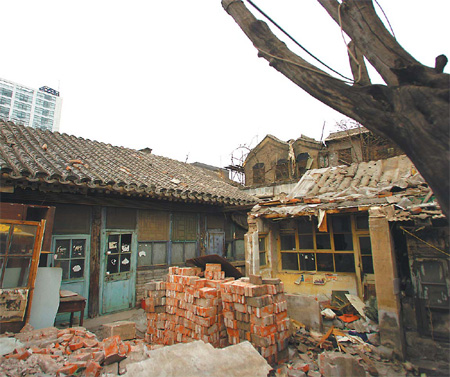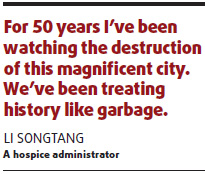
Government and public urged to rescue endangered cultural relics amid the city's rapid urbanization drive
While the demolition of a hutong is a sad scene for most Beijingers, the wrecking crews at least have a silver lining for He Feihao, who grabs the opportunity to hunt for cultural relics.
|
 Former residence of late Chinese scholar Kang Youwei (1858-1927) stands in debris. Zou Hong |
He received a call a few days ago that a hutong in southwestern Beijing would soon be demolished, triggering him to plan a visit to hunt for ancient artifacts before they disappear under piles of rubble.
He works for the Songtangzhai Museum, a courtyard museum in Xuanwu district that houses hundreds of architectural remnants from Beijing's past.
Many of the artifacts would have been destroyed if not for Li Songtang, a hospice administrator who offers a new home to items salvaged by people like He.
Li's idea is straightforward: rescue valuable remnants and showcase them in his private museum to highlight the importance of preserving the past before it is too late.

He has been collecting fragments of Beijing's past for nearly half a century.
"For 50 years I've been watching the destruction of this magnificent city," Li told the New York Times. "We've been treating history like garbage."
Despite Li's efforts, the battle to save Old Beijing is far from over.
In the years leading up to the 2008 Olympics, the redevelopment of the capital reached the frenetic pace that persists today. And those working to save the city's history say they worry bulldozers are crushing cultural artifacts before rescuers have a chance to see them.
"There are laws in place to protect cultural relics," said He Shuzhong, a Chinese lawyer and the head of the Beijing Cultural Heritage Protection Center, a non-governmental organization dedicated to protecting China's historical landmarks.
"But they are not adequately enforced. Even though they are in place, they don't work because the government and developers don't pay attention to them," he said.
A national survey conducted by the State Administration of Cultural Heritage (SACH) revealed more than 30,000 historic sites, including ancient tombs, temples and homes, have disappeared in China during the last three decades as a result of redevelopment.
In Beijing alone, He Shuzhong estimates two-thirds of the historical sites in Haidian district are gone. Only two such sites, old temples, remain in Chaoyang district, he said.
The State Council implemented its Law on Protection of Cultural Relics in 2002, which requires companies or government work units to maintain or renovate any protected sites of cultural importance they occupy.
But developers will only salvage a heritage site if it is in their interest, said He Shezhong.
The projects require a lot of time and money to preserve and maintain at a time when property firms are under pressure to put up new buildings as quickly as possible, he said.
"The demolition is very abrupt," He Shezhong said. "Everything is moving too fast."
However, regulations passed last October by SACH could help to slow the destruction.
The rules, called the Provisional Regulations Governing the Management of the Designation of Cultural Relics, permits the public, for the first time, to submit formal requests to the government to recognize historically significant sites.
"The city is now undergoing rapid urbanization. The protection of tangible and intangible relics is also undergoing a key moment," said Shan Jixiang, director of SACH.
He said the government "is pledging to do its best to make sure memories from the city's past do not vanish".
"The protection of cultural relics is not merely a job for the government. It also calls for the participation of the public," said Shan. "All citizens should cherish them and participate in their protection."
The laws are making a modest difference.
In January, the Beijing Cultural Heritage Protection Center, with strong backing from the public, managed to have the courtyard home of Liang Sicheng, a famous architect, listed as an immovable cultural relic after a five-month battle against demolition.
The home is located at No 24 courtyard house in Beizongbu Hutong, Dongcheng district.
Liang lived there between 1931 and 1937.
Large-scale demolition of Beizongbu Hutong and three other lanes began in May.
Even with one victory, mobilizing people, especially those who reside in hutong, to take action can prove difficult.
Residents living in soon-to-be demolished hutong homes are sometimes offered generous compensation packages and look forward to moving to new apartments with modern heating systems and indoor toilets, features the old lane neighborhoods lack, said He Shezhong.
The Beijing Cultural Heritage Protection Center frequently holds seminars to encourage the public to preserve historical sites in their communities.
"This is the most difficult part of the job," he said. "Some would like to try to protect no matter what happens, but they are only the minority. Most face external pressure to support the demolition even if they don't. It is a very complicated issue."
And also a pressing issue.
With no signs of redevelopment in Beijing slowing anytime soon, public support is crucial to save what has not yet been lost.
"The protection of cultural relics is closely associated with the average person's life. It is also what China is proud of," said He Shezhong.
"Beijing will lose its value, the whole country will lose its value, if Chinese don't cherish relics anymore."